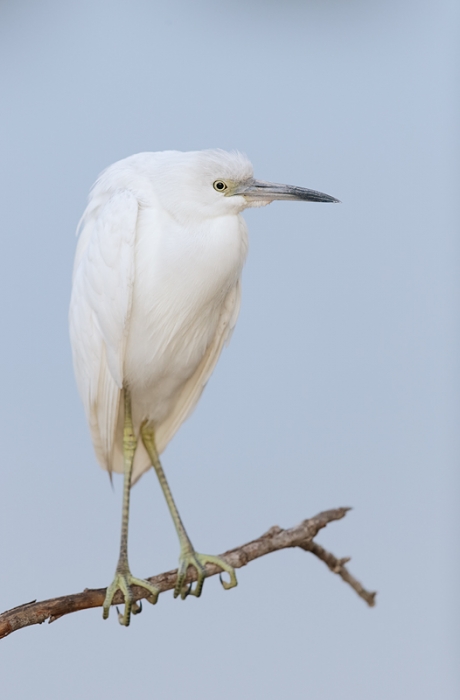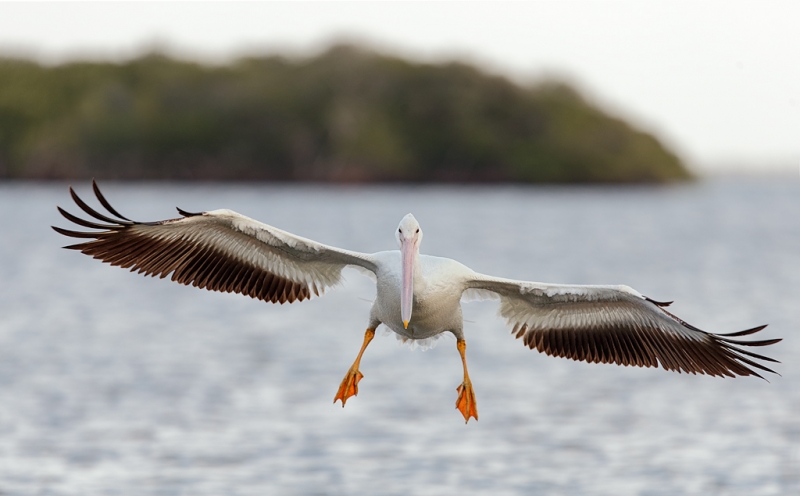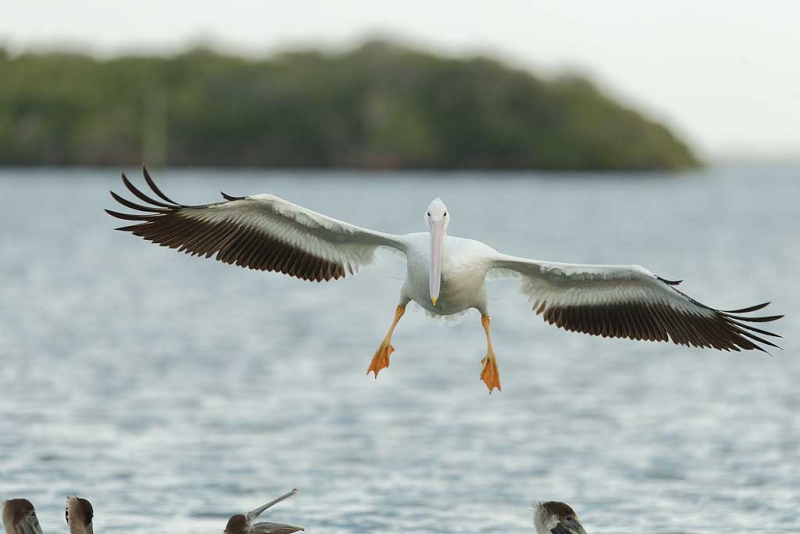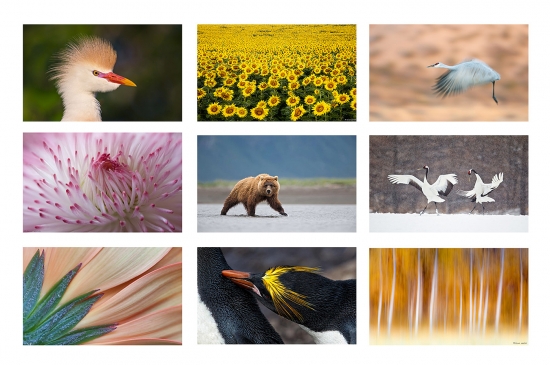|
This Little Blue Heron was photographed in the pre-dawn on the first morning of the SW FLA BIRDS AS ART Instructional Photo-Tour with the tripod-mounted Canon EF 600mm f/4L IS II USM lens and the Canon EOS-1D X Digital SLR . ISO 400. Evaluative metering +1 2/3 stops as framed in Manual mode. Fill-flash at -3 stops with the Canon Speedlite 600EX-RT with the Better Beamer. Learn the basics of fill flash, flash as main light, ETTL, and manual flash in the “Flash Simplified” section of ABP II here. Central sensor Surround/AI Servo/Rear Focus AF on the bird’s eye and recompose. Click here if you missed the Rear Focus Tutorial. Click on the image to see a larger, sharper version. |
Shades of White
I thought it somewhat curious that my two favorite images from the first day of the SW FLA BIRDS AS ART IPT were both of white birds. Learning to handle the WHITEs in both cloudy and sunny conditions is an important part of becoming a competent digital photographer. More on the latter (sunny conditions) coming soon.
|
This White Pelican was photographed on the first afternoon of the SW FLA BIRDS AS ART Instructional Photo-Tour with the hand held Canon EF 300mm f/2.8L IS II USM lens with the Canon 1.4x EF Extender III (Teleconverter) and the Canon EOS-1D X Digital SLR camera body. ISO 800. Evaluative metering + 2 1/3 stops off the light grey sky: 1/1250 sec. at f/4 in Manual mode. This worked out to about +1 1/3 stops as framed. Why? Because the bird and the mangroves were well darker than the sky. Note that in Manual mode the correct exposure on the bird does not change. Only the needle on the analog scale in the viewfinder moves. If you are confused by the above click here, here, and here and start studying. Central sensor/AI Servo Surround/Rear Focus AF active at the moment of exposure. Click here if you missed the Rear Focus Tutorial. Click on the image to see a larger version. If you own a 1D X be sure to check out the info on our EOS-1D X Autofocus Guide below. |
Your Favortie?
Which of the two images do you like best? If you leave a comment, please let us know why.
Pelican Flight Location
One of the very few BIRDS AS ART “secret” locations if our first afternoon pelican spot. You get to photograph both Brown and White Pelicans in flight until your arms fall off. We share everything about this great spot in the SW FLA Site Guide. Your purchase includes free update. I am planning to update the guide for the first time in years this coming March. Check out all of our great Site and Set-up Guides here.
Be sure to check out the original image below. Big time thanks to multiple IPT-participant Gaurav Mittal of New Dehli India who was attending his fourth IPT; he called out, “Incoming White Pelican on the right.” Else I would have missed this image. Gaurav was quite skilled when he came on his first IPT and has been improving by leaps and bounds since then. I love serious students. You can see some of his excellent work here. It will be hard to believe that he has been photographing birds for only 15 months….
|
I created the optimized White Pelican image above from the original here. |
White Pelican Image Optimization
Comparing the original capture with the image above reveals that I cropped from the left and below, the former for better compositional balance, the latter to eliminate several unwanted pelican heads. The BLUE/CYAN/GREEN color cast was eliminated using a 70% Average Blur Color Balance adjustment. The large, distracting vertical shape above the tips of the bird’s right primary tips was covered with a Quick Mask and fine-tuned with a Layer Mask. All of the above as detailed in Digital Basics which includes my complete digital workflow, dozens of great Photoshop tips, Layer Masking for Dummies, all of my Keyboard Shortcuts, and tons more. Digital Basics, a PDF that is sent via e-mail, will be the best $25 you’ll ever spent on your photography. Your purchase includes free updates. Learn advanced Quick Masking techniques in APTATS I and advanced Layer Masking Techniques in APTATS II.
Seriously Huge B&H Savings on Nikon and Canon Gear
Nikon
For the first time in many years NIKON is going to be deeply discounting many legacy pro lenses individually for the next 2 weeks only with discounts up to $350. There are also many amazing deals on NIKON Buy together and Save packages as well. Click here to save.
Nikon DSLRS Bundles with Lenses & Flash: Save up to $750. Click here to save. Make sure to add each item to your shopping cart to see the absolute lowest price.
Canon Lenses & Speedlites: Save Up to $300
Click here to save. Make sure to add each item to your shopping cart to see the absolute lowest price.
Canon Buy Together & Save: Save Up to $400
Click here to save.
EOS-1D X AF Guide
You can learn exactly how I set up and use this camera’s great new AF system in our EOS-1D X AF Guide. And you can learn about our camera User’s Guides here.
Southwest Florida Site Guide
Several folks have written recently asking why this great guide has not been updated since 2007. The answer is that I have not discovered any new hotspots and that the good places remain good and the great places remain great. We found the Snowy Plovers on Wednesday in the exact spot described in the Southwest Florida Site Guide. Go figure.
Africa Photo Safari: August 2013
Serengeti Summer Migration Safari: 12 full and two half-days of photography: $12,999/person double occupancy. Limit: 12/Openings: 9.
Leaders: Todd Gustafson, Denise Ippolito, and Arthur Morris. Tanzania Summer Migration Safari. Leave the US on August 3. Day 1 of the safari is August 5. We will visit Tarangire for great dry season photography, Seronera Lodge–aka Leopard City!–twice, Central Serengeti for big cats, Northern Serengeti and our mobile tented camp to search for river crossings, and the spectacular wildlife spectacle that is Ngorongoro Crater. Our last morning of photography is August 18. Fly home from Arusha, Tanzania on the evening of August 18.
A deposit of $4,000 is due now. This trip is a go. Happy Campers only please. Guaranteed maximum no more than 12 photographers plus the three great leaders. 3 persons/van. You get a row of seats for yourself and your gear. In addition to rotating in-the-field instruction with each of the co-leaders, artie, Todd, and denise will be available for image sharing and review and informal Photoshop instruction during breaks and after meals. And–with apologies to Miss Manners–even during meals!
Once we cash your check you will be strongly advised to purchase travel insurance. You may wish to consider using Travel Insurance Services. Do understand that most policies must be purchased within two weeks of our cashing your deposit check. The 2nd payment of $4000 is due MAR 30, 2013. The final payment/balance is due MAY 30, 2013. Sign up with a friend or a spouse and apply a $300 per person discount.
The lodging is all first class. Please e-mail to request a PDF with additional details, the complete itinerary, and a description of the unparalleled photographic opportunities that we will enjoy. Please e-mail or call me on my cell at 1-863-221-2372 with any questions. I hope that you can join us.
You can see a collection of my images from previous safaris here.
Weekend Creative Nature Photography Seminar, Tampa, FL: February 23 & 24, 2013: $149
You are invited to join Denise Ippolito and me on the weekend of February 23-24 on the outskirts of Tampa, FL for a great weekend of fun and learning. Learn to improve your photography skills, your skill at designing images in the field, your creative vision, and your image optimization skills. Sunday critiquing session. Click here for additional details and the complete schedule.
Fort DeSoto Morning In-the-Field Workshop/Two Slots Left!
Fort DeSoto In-the-field Workshop: FEB 25. Pre-dawn -10:30am. Strict Limit 16/2 Openings. Includes a great working lunch: $275.
On Monday morning, February 25, Denise Ippolito and I will be co-leading a morning In-the-field Workshop at Fort DeSoto, south of St. Petersburg, FL. We should get to photograph a variety of very tame herons, egrets, gulls, terns, and shorebirds. Spoonbills possible. There will be lots of individual and small group instruction. We will cover exposure and histograms, seeing the situation, creating sharp images, and lots more. Each registrant will have a personalized gear and set-up check. The more questions you ask, the more you will learn.
A great working lunch at the Sea Porch Café on St. Petersburg Beach is included. All are invited to bring a laptop along for image sharing at lunch. After the workshop, all are invited to send us three 1024 wide or 800 tall JPEGs for critiquing. Call 1-863-692-0906 to register or send us a Paypal. Either way, be sure to note that the payment is for the Fort DeSoto In-the-Field Workshop.
Typos
On all blog posts, feel free to e-mail or leave a comment regarding any typos, wrong words, misspellings, omissions, or grammatical errors. Just be right. 🙂
Support the BAA Blog. Support the BAA Bulletins: Shop B&H here!
We want and need to keep providing you with the latest free information, photography and Photoshop lessons, and all manner of related information. Show your appreciation by making your purchases immediately after clicking on any of our B&H or Amazon Affiliate links in this blog post. Remember, B&H ain’t just photography!
Support the BAA Blog. Support the BAA Bulletins: Shop Amazon here!
And from the BAA On-line Store:
LensCoats. I have a LensCoat on each of my big lenses to protect them from nicks and thus increase their re-sales value. All my big lens LensCoat stuff is in Hardwood Snow pattern.
LegCoat Tripod Leg Covers. I have four tripods active and each has a Hardwood Snow LegCoat on it to help prevent further damage to my tender shoulders :) And you will love them in mega-cold weather....
Gizo GT3532 LS CF Tripod. This one replaces the GT3530LS Tripod and will last you a lifetime. Learn more about this great tripod here.
Mongoose M3.6 Tripod Head. Right now this is the best tripod head around for use with lenses that weigh less than 9 pounds. For heavier lenses, check out the Wimberley V2 head.
Double Bubble Level. You will find one in my camera's hot shoe whenever I am not using flash.
The Lens Align Mark II. I use the Lens Align Mark II pretty much religiously to micro-adjust all of my gear an average of once a month and always before a major trip. Enjoy our free comprehensive tutorial here.
BreezeBrowser. I do not see how any digital photographer can exist without this program.
Delkin Flash Cards. I use and depend on Delkin compact Flash Cards and card readers most every day. Learn more about their great 700X and 1000X cards here or about my favorite Delkin card here.


















Hi Arthur,
I prefer the White Pelican image, with it’s outstretched wings, landing gear down and long bill straight on to the camera (the orange on the tip of the bill nicely matches the orange of the legs and feet). I also like that it is placed in context by the out of focus water and strip of land with sky above it (these also help to frame the bird). The crop used nicely makes the pelican the main focus of interest and give us it larger in the frame showing more detail. All in all a lovely image – can’t see anything I dislike or how it could be improved in anyway! 🙂
I do have a suggestion for the guides. Maybe in the store, indicate
what ‘version’ the guide is. With people changing email addresses,
leaving photography and coming back, etc., if they have some type
of version to check against in your store, they’ll be able to tell
instantly if they missed an update.
For example you mentioned it has been 2007. My last update was December
2006 (emailed in January of 2007). With some type of version I can easily
check what I have versus what’s for sale and see if I missed any.
Doug
Good idea. Please remind me via e-mail in ten days. Thanks, artie
Hi Artie – just noticed a typo. The second photograph is labeled as a Little Blue Heron. Great shots and learning as always! Steve
Good catch! I was working to fast in the early morning. Many thanks. artie
Artie
The Little Blue Heron photo is the White Pelican 🙂
Myer
Thanks Myer. Early brain typo 🙂